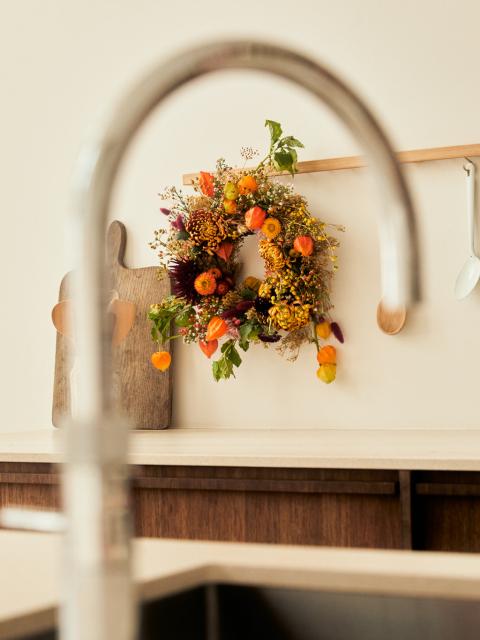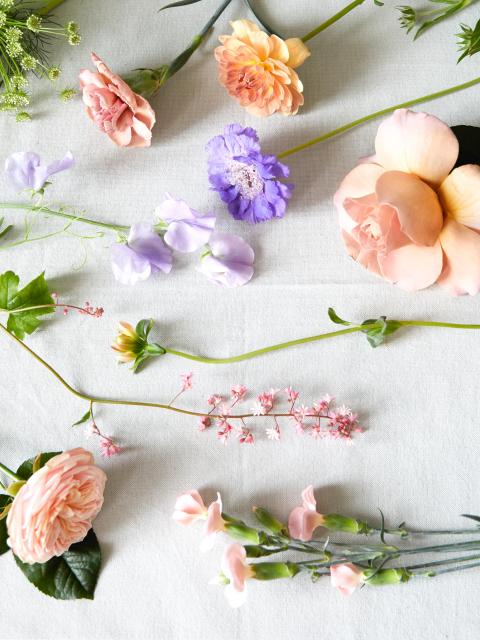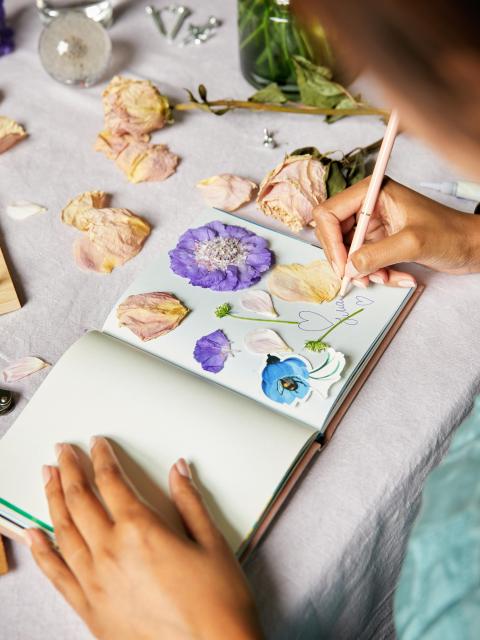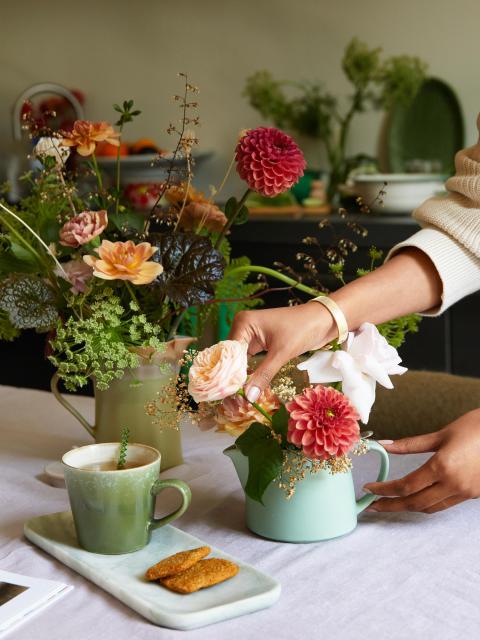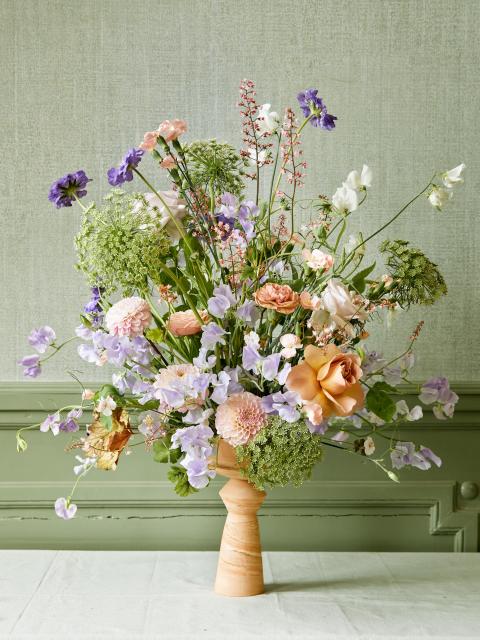WHAT DO DAHLIAs LOOK LIKE?
Dahlias have quite a striking appearance, with its petals being the most impressive: sometimes they're solid in colour, but often they're strikingly bright with speckles or stripes. Some flowers have a single row of petals, while others have dozens. This beautiful flower has huge variations in shape and colour. The petals can be round, spiky or coiled and come in many colours, including red, pink, orange, white, yellow, purple and many shades in between. Some varieties have multiple colours in one flower. Dahlias have deep green leaves, which can contrast with the bright colours of the flower. The leaves grow along the stems and give the flower a full and lush appearance.
what are the different varieties of dahlia?
The Dahlia belongs to the Asteraceae family, which also includes flowers such as chrysanthemums and asters. There are thousands of varieties of dahlias. The flower is very popular and new varieties are created regularly. The most well-known varieties of dahlia are cactus dahlias, pompon dahlias, single flower dahlias and decorative dahlias. Within these species there are endless variations in colour, size and shape.
- Cactus dahlia: this species can be recognised by its prickly, curved petals that are largely rolled up. The leaves of this species are often narrow and pointed.
- Pompon dahlia: the pompon dahlia is a small, spherical and well-filled flower. The leaves are rolled up in funnel shape and in towards the centre the petals are rolled up narrower and narrower.
- Single flower dahlia: these dahlias have simple flowers with a row of petals around a central disc. They have a classic, natural look and resemble daisies.
- Decorative dahlia: these dahlias are characterised by large, full flowers with layered petals.
- Water lily dahlia: the water lily dahlia is known for its wide, flat and open flowers that resemble water lilies.

HOW AND WHEN DO DAHLIAS FLOWER?
Dahlias flower from their bulbs, which grow underground. These bulbs resemble potatoes and contain nutrients that support the plants during the growing season. Stems with green leaves and flower buds develop from each dahlia bulb. The flower buds develop into beautiful flowers. Dahlias generally flower from summer to autumn (from around July to November), depending on the variety and climatic conditions.
how to care for a bouquet of dahlias
Want to enjoy cut dahlias in your vase for as long as possible? These tips will help:
- Cut the flower stems diagonally with a clean and sharp knife before putting them in your vase.
- Put the dahlias in a clean vase with water at room temperature.
- Remove excess leaves and make sure no leaves hang into the vase water, as they will rot.
- Add cut flower food to extend the life of your dahlias
- Change the vase water regularly (every few days).
- Put dahlias in the right spot: not in a draught and not next to a fruit bowl.
how to plant dahlias in your garden
Looking to plant this gorgeous bloom in your garden? Make sure you do so by spring, as soon as the risk of frost has passed (around April or May). Growing dahlias yourself is relatively easy. Check out our step-by-step plan for planting dahlias in your garden below:
- Choose healthy-looking bulbs with no signs of disease or rot.
- Choose a spot in your garden (for planting dahlias on your balcony or other outdoor space, see our separate instructions below) with plenty of sunlight. Dahlias need at least six hours of sunlight a day.
- Dahlias thrive best in well-drained soil. Make sure the soil you're planting in is loose enough and add compost to make it more fertile.
- Place the bulb about 10-15 centimetres deep int the soil. Place the bulb with the eye facing upwards and cover i with soil.
- Keep a space of 45-60 centimetres between each bulb.
- Water the bulbs after planting.
how to plant dahlias in a pot
Don't have a garden, but want to plant dahlias in pots for your balcony? Or are you hoping to propagate out your dahlia (this means planting them in a pot first before planting them in the garden)? It's easy! The advantage of planting dahlias in pots is that you can keep the soil temperature higher and have more control over growth conditions (watering, fertiliser, etc.). If you grow (propagate) your dahlias in a pot before planting them out in your garden, your dahlias will have around a six week head start on flowering, and you can enjoy their blooms even longer. Check out the following step-by-step plan for planting or propagating potted dahlias:
- Plant dahlia bulbs in pots in February or March.
- Use pots with good drainage and fill them with high-quality potting soil.
- Place the bulb about 3 centimetres deep in the potting soil, facing upwards.
- Water the soil sufficiently. Make sure the soil is moist, but not too wet.
- Put the pots in a light, frost-free place (such as in a greenhouse or conservatory). The ideal temperature is 8-15 °C.
- After the chance of frost has passed - around April or May - you can plant the dahlia in your garden, or leave it in the pot.
TIPS FOR CARING FOR DAHLIAS IN YOUR GARDEN
Have you planted dahlias in your garden? Water them regularly during dry periods to keep the roots well hydrated, but avoid soaking the soil continuously as this can cause root rot. Use fertiliser in spring and midway through the growing season to provide your dahlias with extra nutrition. Many dahlia varieties can grow quite tall. If necessary, place sturdy canes next to the plants and tie the stems to them as they grow.
how to harvest and cut dahlias
Have you planned dahlias in your garden in order to harvest them as cut flowers for your vase? Wait to harvest the dahlias until their flower buds are almost fully opened. Use sharp pruning shears, and when cutting make sure you remove a dahlia just above a bud so that the next flower can develop from the bud.

SHOULD YOU PRUNE DAHLIAS?
To keep your dahlias compact and healthy and to ensure as many flowers as possible, pruning is necessary. When pruning dahlias, you should distinguish between three different pruning periods:
- First pruning: it's advisable to prune the tops of young shoots when they are about 30 centimetres high. This is because by removing the top buds, you encourage the plant to develop side branches. This encourages branching and produces more flowers.
- Midyear check: remove dead or faded flowers throughout the growing season. This ensures that the dahlia forms new flower buds and extends the flowering period.
- Autumn pruning: at the end of the growing season, when the frosts have started, it's time to prune your dahlias back. Cut the stems of the plant to 15-20 centimetres above the ground. This prepares the plant for winter.
SYMBOLISM OF DAHLIAS
The Dahlia has several symbolic meanings. The fact that dahlias grow from bulbs underground and return year after year is seen as a symbol of inner strength and growth. The beautiful petals and lush flowers mean that dahlias also symbolise elegance. In addition, the flower is seen as a symbol of eternal love. If you give a bouquet of dahlias to a loved one, you are saying 'forever yours'. Finally, because of their beautiful colours and shapes, dahlias are associated with cheerfulness and positive energy.
WHERE DO DAHLIAS COME FROM?
The dahlia is originally a Mexican plant. Dahlia bulb were used in Mexico by indigenous people for medicinal purposes (the juice from the bulb was said to be healing for wounds) and as an edible crop (bulbs were boiled and eaten).
During the Spanish colonisation of Mexico in the 16th century, dahlias were discovered by Spanish explorers and botanists. In the 18th century, European botanists began to study and describe the dahlia. The first dahlia bulb were sent to the Royal Botanical Garden in Madrid. From there, the dahlia spread to other European botanical gardens and became a very popular flower.
The name 'dahlia' was given to the flower in honour of Swedish botanist Anders Dahl. This botanist played an important role in the description and documentation of the dahlia. Today, the dahlia is a very popular flower worldwide and is grown all over the world.








